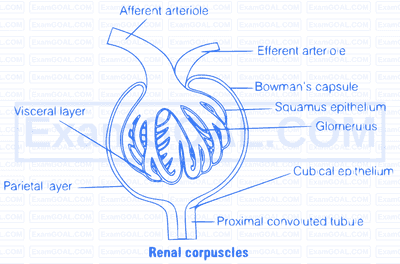28
Complete the following
(a) Urinary excretion $=$ tubular reabsorption + tubular secretion -
(b) Dialysis fluid = plasma -
Explanation
(a) Urinary excretion $=$ tubular reabsorption + tubular secretion - filtration
(b) Dialysis fluid = plasma - nitrogenous wastes.
29
Mention the substances that exit from the tubules in order to maintain a concentration gradient in the medullary interstitium.
Explanation
The concentration gradient in medullary interstitium is established primarily by renal tubules of loop of Henle and the blood vessels surrounding them (vasa recta) in a process called countercurrent exchange.
The substances that exit from tubules for maintenance of such gradient are mainly sodium chloride $(\mathrm{NaCl})$, water and urea (contaning $\mathrm{H}^{+}, \mathrm{K}^{+}$and $\mathrm{NH}_3^{+}$).
30
Fill in the blanks appropriately
| Organ | Excretory wastes | |
|---|---|---|
| (a) | Kidneys | ...................... |
| (b) | Lungs | ..................... |
| (c) | Liver | .................... |
| (d) | Skin | .................... |
Explanation
| Organ | Excretory wastes | |
|---|---|---|
| (a) | Kidneys | Urine |
| (b) | Lungs | CO$_2$ |
| (c) | Liver | Urea |
| (d) | Skin | Sweat |
31
Show the structure of a renal corpuscle with the help of a diagram.
Explanation
Representing the structure of a renal corpuscle

32
What is the role played by renin-angiotensin in the regulation of kidney function?
Explanation
Renin is released from the Juxta-Glomerular Apparatus (JGA) on activation by fall in the glomerular blood pressure/flow. Renin converts angiotensinogen in blood to angiotensin I and further to angiotensin II. Angiotensin II, being a powerful vasoconstrictor, increases the glomerular blood pressure and thereby Glomerular Filteration Rate (GFR).
Angiotensin II also activates the adrenal cortex to release aldosterone. Aldosterone causes reabsorption of $\mathrm{Na}^{+}$and water from the distal parts of the tubule. This also, leads to an increase in blood pressure and GFR. This complex mechanism is generally known as Renin Angiotensin Aldosterone System or RAAS.